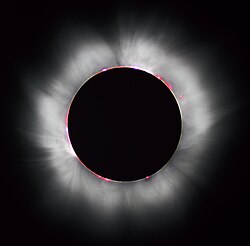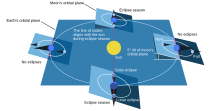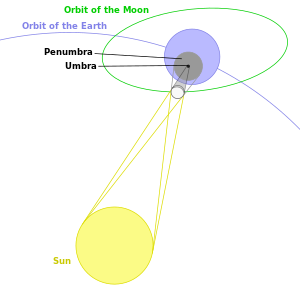
A lunar eclipse is an astronomical event that occurs when the Moon moves into the Earth's shadow, causing the Moon to be darkened. Such an alignment occurs during an eclipse season, approximately every six months, during the full moon phase, when the Moon's orbital plane is closest to the plane of the Earth's orbit.

In astronomy, a conjunction occurs when two astronomical objects or spacecraft appear to be close to each other in the sky. This means they have either the same right ascension or the same ecliptic longitude, usually as observed from Earth.

The umbra, penumbra and antumbra are three distinct parts of a shadow, created by any light source after impinging on an opaque object. Assuming no diffraction, for a collimated beam of light, only the umbra is cast.

A shadow is a dark area where light from a light source is blocked by an object. It occupies all of the three-dimensional volume behind an object with light in front of it. The cross section of a shadow is a two-dimensional silhouette, or a reverse projection of the object blocking the light.

In astronomy, an extraterrestrial sky is a view of outer space from the surface of an astronomical body other than Earth.
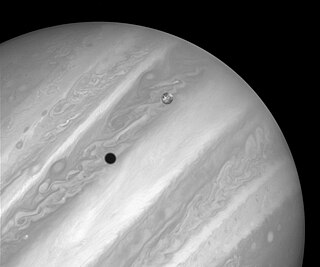
Solar eclipses on Jupiter occur when any of the natural satellites of Jupiter pass in front of the Sun as seen from the planet Jupiter.

The magnitude of eclipse is the fraction of the angular diameter of a celestial body being eclipsed. This applies to all celestial eclipses. The magnitude of a partial or annular solar eclipse is always between 0.0 and 1.0, while the magnitude of a total solar eclipse is always greater than or equal to 1.0, and has a theoretically maximum value of around 1.12.

A solar eclipse occurs when the Moon passes between Earth and the Sun, thereby obscuring the view of the Sun from a small part of Earth, totally or partially. Such an alignment occurs approximately every six months, during the eclipse season in its new moon phase, when the Moon's orbital plane is closest to the plane of Earth's orbit. In a total eclipse, the disk of the Sun is fully obscured by the Moon. In partial and annular eclipses, only part of the Sun is obscured. Unlike a lunar eclipse, which may be viewed from anywhere on the night side of Earth, a solar eclipse can only be viewed from a relatively small area of the world. As such, although total solar eclipses occur somewhere on Earth every 18 months on average, they recur at any given place only once every 360 to 410 years.

The two moons of Mars, Phobos and Deimos, are much smaller than Earth's Moon, greatly reducing the frequency of solar eclipses on that planet. Neither moon's apparent diameter is large enough to cover the disk of the Sun, and therefore they are annular solar eclipses and can also be considered transits.

A total lunar eclipse occurred on February 20 and February 21, 2008. It was visible in the eastern evening sky on February 20 for all of North and South America, and on February 21 in the predawn western sky from most of Africa and Europe. Greatest Eclipse occurring on Thursday, February 21, 2008, at 03:26:03 UTC, totality lasting 49 minutes and 45.6 seconds.

A total lunar eclipse took place on 15 April 2014. It was the first of two total lunar eclipses in 2014, and the first in a tetrad. Subsequent eclipses in the tetrad are those of 8 October 2014, 4 April 2015, and 28 September 2015. Occurring 6.7 days after apogee, the Moon's apparent diameter was smaller.

A total lunar eclipse took place on Wednesday 8 October 2014. It is the second of two total lunar eclipses in 2014, and the second in a tetrad. Other eclipses in the tetrad are those of 15 April 2014, 4 April 2015, and 28 September 2015. Occurring only 2.1 days after perigee, the Moon's apparent diameter was larger, 1960.6 arcseconds.
A partial lunar eclipse took place on Saturday, June 25, 1983, the first of two lunar eclipses in 1983 with an umbral eclipse magnitude of 0.33479. A partial lunar eclipse happens when the Earth moves between the Sun and the Full Moon, but they are not precisely aligned. Only part of the Moon's visible surface moves into the dark part of the Earth's shadow. A partial lunar eclipse occurs when the Earth moves between the Sun and Moon but the three celestial bodies do not form a straight line in space. When that happens, a small part of the Moon's surface is covered by the darkest, central part of the Earth's shadow, called the umbra. The rest of the Moon is covered by the outer part of the Earth's shadow called the penumbra. The Earth's shadow on the moon was clearly visible in this eclipse, with 33% of the Moon in shadow; the partial eclipse lasted for 2 hours and 15 minutes.
A partial lunar eclipse occurred on Tuesday, July 25, 1972 and Wednesday, July 26, 1972, the second of two lunar eclipses in 1972 with an umbral eclipse magnitude of 0.54271. A partial lunar eclipse occurs when the Earth moves between the Sun and Moon but the three celestial bodies do not form a straight line in space. When that happens, a small part of the Moon's surface is covered by the darkest, central part of the Earth's shadow, called the umbra. The rest of the Moon is covered by the outer part of the Earth's shadow called the penumbra. The moon's apparent diameter was 3.2 arcseconds smaller than the January 30, 1972 lunar eclipse.

A penumbral lunar eclipse took place at the Moon's ascending of the orbit on Sunday, June 5, 1955, with a penumbral eclipse magnitude of 0.62181 (62.181%). A penumbral lunar eclipse takes place when the Moon moves through the faint, outer part of Earth's shadow, the penumbra. This type of eclipse is not as dramatic as other types of lunar eclipses and is often mistaken for a regular Full Moon. The Moon shines because its surface reflects the Sun's rays. A lunar eclipse happens when the Earth comes between the Sun and the Moon and blocks some or all of the Sun's light from reaching the Moon. A penumbral lunar eclipse occurs when the Sun, Earth, and the Moon are imperfectly aligned. When this happens, the Earth blocks some of the Sun's light from directly reaching the Moon's surface and covers all or part of the Moon with the outer part of its shadow, also known as the penumbra. Since the penumbra is much fainter than the dark core of the Earth's shadow, the umbra, a penumbral eclipse of the Moon is often difficult to tell apart from a normal Full Moon. Occurring only 0.5 days after apogee, the moon's apparent diameter was 6.5% smaller than average.
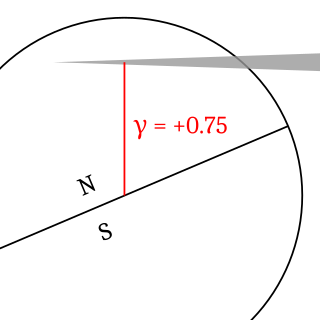
Gamma of an eclipse describes how centrally the shadow of the Moon or Earth strikes the other body. This distance, measured at the moment when the axis of the shadow cone passes closest to the center of the Earth or Moon, is stated as a fraction of the equatorial radius of the Earth or Moon.

The solar eclipse of May 20, 2012 was an annular solar eclipse that was visible in a band spanning through Eastern Asia, the Pacific Ocean, and North America. As a partial solar eclipse, it was visible from northern Greenland to Hawaii, and from eastern Indonesia at sunrise to northwestern Mexico at sunset. The moon's apparent diameter was smaller because the eclipse was occurring only 32 1/2 hours after apogee.

In astronomy, a syzygy is a roughly straight-line configuration of three or more celestial bodies in a gravitational system.

Solar eclipses on Saturn occur when the natural satellites of Saturn pass in front of the Sun as seen from Saturn. These eclipses happen fairly often. For example, some of Saturn's moons can have a solar eclipse every day depending on the saturnian season.
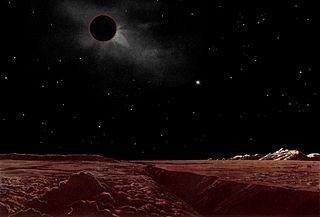
Solar eclipses on the Moon are caused when the planet Earth passes in front of the Sun and blocks its light. Viewers on Earth experience a lunar eclipse during a solar eclipse on the Moon.
